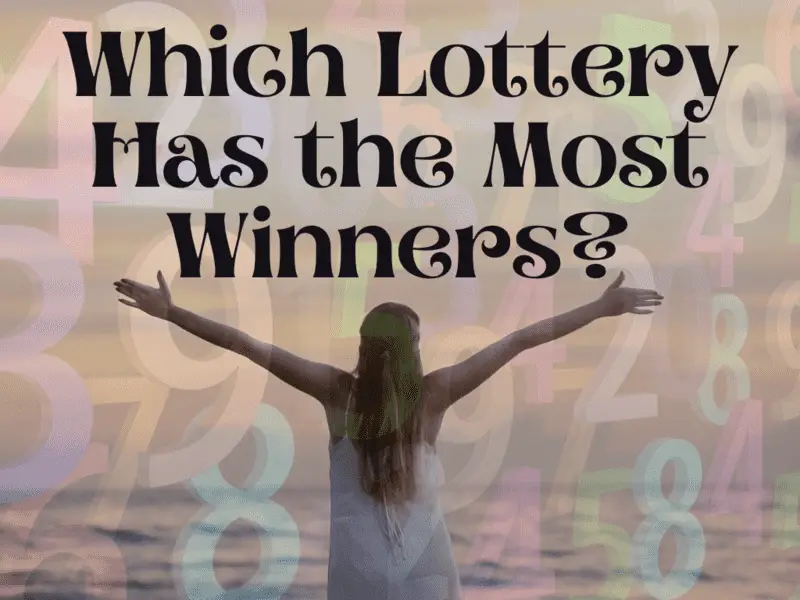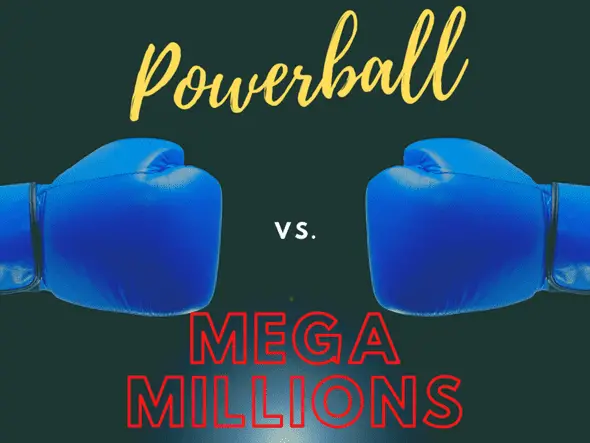Which Lottery Has the Most Winners?
Nothing beats winning the jackpot in the lottery, especially if you’re the sole winner of October 23, 2018, Mega Millions $1.537 billion (annuity value) or $878 million (lump sum value). There’s also Powerball’s $1.586 billion on January 13, 2016, split between 3 winning tickets. But through the years, which of these lotteries had the most winners?
Since May 17, 2002’s $28 million jackpot, there’s been a total of 189 winners for Mega Millions, including the biggest single-winner payout in history—$1.537 billion. Powerball had a total of 197 winners since February 1, 2003, including the biggest jackpot in history—$1.586 billion!
However, if you’re playing both lotteries, there’s more that you need to consider other than the number of winners. You also need to consider your odds in winning the jackpot and smaller prizes. Stick around as we cover these in great detail and help you find out which gives you a better chance.
Powerball
Powerball is a lottery game that you can play in one of the 45 states of the US, the District of Columbia, Puerto Rico and the US Virgin Islands. The non-profit Multi-State Lottery Association (MUSL) manages this lottery, and it advertises itself as having a minimum jackpot of $20 million.
On January 13, 2016, Powerball officially became the lottery with the biggest jackpot, with its $1.586 billion first prize. However, the amount that the winners received isn’t as jaw-dropping as what some people think. There are three winning tickets in this draw from 3 different states: Chino Hills, California; Munford, Tennessee; and Melbourne Beach, Florida. They all received a check with an annuity value of $528.8 million or a much lower one-time lump sum payment.
Powerball replaced Lotto America in 1992, a lottery that started in 1988. Each Powerball ticket initially costs $1, but they increased it to $2 or $3 after the introduction of Power Play. It’s an option that allows a person to play at 2x or 5x the jackpot; if the amount is lower than $150 million, they can opt to play for 10x.
On January 15, 2012, players needed to pick five numbers from a set of 59 white balls and one from a set of 35 red balls (Powerballs) to win the jackpot, which has a probability ratio of 1:175,223,510. On October 7, 2015, they adjusted the numbers of white and red balls; players can now pick five numbers from a set of 69 white and 26 red balls, lowering the probability ratio to 1:292,201,338.
Mega Millions
The Big Game, Mega Millions’ predecessor, started in 1996 and is initially only available to 6 states: Georgia, Illinois, Maryland, Massachusetts, Michigan, and Virginia. As of January 20, 2020, Mega Millions is available in 45 states of the US, the District of Columbia, and the US Virgin Islands.
Even if we consider its predecessor, Mega Millions is still a newcomer in the lottery. However, it made headlines on October 23, 2018, when a single ticket won $1.537 billion. Even after taking the lump sum of $877,784,124 before taxes, it remains the biggest payout ever made in the lottery on a single ticket.
Aside from being four years younger than Powerball and eight years younger than its predecessor, Lotto America, another reason why The Big Game (Mega Millions) has fewer winners is that it has a much lower probability ratio with only 1:302,575,350.
Players needed to pick five numbers from a set of 70 white balls and one from 25 gold balls to win the jackpot. Despite this, people still play Mega Millions because it has twice the minimum prize at $40 million, which grows until someone wins. It also has a higher probability that a person will win anything when compared with Powerball.
Powerball & Mega Millions: Side by Side Comparison
There are many other smaller lotteries that you can play, but Powerball and Mega Millions are two of the biggest lotteries available in almost every US state. Although the gameplay is very different, there’s one common denominator between the two: jaw-dropping jackpots! To help you get a better view of which lottery can give you the best chance to win, here’s a quick comparison of the two:
| Powerball | Mega Millions | |
|---|---|---|
| Starting Date | 1988 as Lotto America and 1992 as Powerball | 1994 as The Big Game and 2002 as Mega Millions |
| Minimum Jackpot | $20 million* | $40 million* |
| Odds to Win the Jackpot | 1:192,201,338 | 1:302,575,350 |
| Odds to Win Small Prizes | 1:24.8 | 1:24 |
| Jackpot Wins Since 2000 | 197 | 189 |
| Biggest Jackpot | $1.586 billion* | $1.537 billion* |
| Biggest Single Ticket Jackpot | $768.4 million* | $1.537 billion* |
*Lotteries advertise their jackpots in annuity value, payable in 30 years, and adjusted for inflation. Players also have the option to take a smaller one-time lump sum payment.
Powerball gives you a better chance to win the jackpot with a probability ratio of 1:192,201,338. It’s evident with the number of winners that they have had since the 2000s. We had to shorten the comparison date to make it an even match between the two lotteries. That’s because Powerball has more years in operation; since 1988 as opposed to Mega Millions that only started in 1996.
If we look at the history of the biggest winnings, Powerball also takes 4 of the top 5 highest jackpots in history. However, the massive payout that Mega Millions made on October 23, 2018, trumps all the lotteries in history. The sole winner collected a lump sum payout of $877,784,124 before taxes! Add this to the much higher minimum jackpot that is twice the minimum jackpot for Powerball, and it’s easy to see why many still play the Mega Millions.
Five Biggest Jackpots in Powerball
We ranked the biggest jackpot by its advertised annuity value. However, you’ll soon find out that, sometimes, winning the biggest prize doesn’t always mean you’re getting the biggest payout. Here are the five biggest jackpots ever won on Powerball:
- The record-breaking $1.586 billion jackpot came to an end on January 13, 2016. It was the first time a lottery jackpot has reached $1 billion. However, the winning tickets only amounted to $528.8 million after splitting it between three winning tickets sold in California, Florida, and Tennessee. It’s not the highest single-ticket jackpot in Powerball history, but it’s the most significant payout ever in the lottery.
- The $768.4 million jackpot on March 27, 2019, trumps the first because it was the highest single-ticket jackpot in Powerball history. The winner from Wisconsin had to choose between a lump sum of $477 million or $768.4 million in annuity value.
- The $758.7 million jackpot on August 23, 2017, was the biggest lump sum payment Powerball has ever made due to technicalities and inflation rates. Mavis Wanczyk from Massachusetts chose the $480.5 million lump sum instead of a much higher annuity value.
- The $687.8 million on October 27, 2018, was split between two winning tickets from Iowa and New York. Each of them will receive $343.9 million in annuity value, which could have considerable differences due to state and municipal taxes.
- The jackpot of $590.5 million on May 18, 2013, is technically the fourth biggest jackpot in Powerball history after Gloria MacKenzie from Florida single-handedly took home a lump sum of $370.9 million or approximately $278 million after taxes.
Five Biggest Jackpots in Mega Millions
Despite having fewer winners, Mega Millions still trumps the biggest single-winning payout in history. These jackpots are also close to the payouts that Powerball made in terms of single-winning tickets. Here are the five biggest prizes in the history of Mega Millions:
- The $1.537 billion on October 23, 2018, remains the world’s biggest single-ticket jackpot with the lucky winner from South Carolina. It’s one of the very few states that allow lottery winners to remain anonymous, but we know that the winner is one lucky woman! She only claimed her prize on March 4, just a few weeks before the deadline. The winner took home a whopping $877,784,124 lump sum before taxes!
- The $656 million on March 30, 2012, was the second-biggest payout in Mega Millions history, but it was a split between three winning tickets sold in Maryland, Illinois, and Kansas. The winners had the option to take $218 million in annuity value or a much lower lump sum, which is still a significant amount compared to other lottery jackpots.
- The $648 million on December 17, 2013, was a split between two winning tickets in Georgia and California. The amount that they received from Mega Millions is a staggering $324 million in annuity value or $173.85 million lump sum before taxes.
- The $543 million jackpot on July 24, 2018, was the second-largest single-ticket payout and third-largest cash value payout in the history of Mega Millions. The winner from California had to choose between $543 million in annuity value or $320 million lump sum.
- The $536 million jackpot on July 8, 2016, was the biggest in Hoosier Lottery history, the third biggest single-ticket payout, and the second-biggest cash value payout in Mega Millions history. The family from Indiana had to choose between $536 million in annuity value or $378 million lump sum before taxes.
The Odds to Win the Jackpot
There is a mathematical explanation with the number of jackpot winners of Powerball and Mega Millions. Both look like they provide the same probability with their gameplay: pick five white balls in any order from a set of 69 in Powerball and 70 in Mega Millions, then one red or gold ball from 26 in Powerball and 25 in Mega Millions.
Both Powerball and Mega Millions use 95 balls when drawing the winner. However, as you will learn, the slight variation with its gameplay resulted in a difference of 10,374,012 odds to win the jackpot. That gives anyone a 3.55% higher chance of winning the prize compared to its counterpart.
The Odds to Win the Powerball Jackpot
There are 69 white and 26 red balls when playing the Powerball. To win the jackpot, you need to pick the exact numbers in any combination, which brings your chance to win at 1:C(69, 5) × 26.
What this formula means is that you have 1:69 chance to hit the first number, then 1:68 to get the second number, 1:67 for the third, 1:66 to pick the fourth correctly, and 1:65 for the last ball—that’s 69 × 68 × 67 × 66 × 65. Divide the total to the product of 5×4×3×2×1 or 120. Multiply it by 26—the number of red balls that you can choose from when playing Powerball.
If we put all of those variables together, we can formulate and accurately to calculate your odds in winning the Powerball jackpot:
(69 × 68 × 67 × 66 × 65) ÷ 120 × 26 = 292,201,338
So, each ticket in Powerball has the chance to win 1:292,201,338. In other words, you’d have to buy 292,201,338 million unique tickets in a single draw to guarantee that you’ll win the jackpot. That’s an excellent source of easy-money if you can overcome the funds and the logistics requirement of processing 97,400,446 tickets daily for 3 or 4 days or 4,058,352 per hour.
The Odds to Win the Mega Millions Jackpot
Mega Millions have 70 white walls and 25 gold balls, which looks as promising as the Powerball, but using the same formula to calculate the odds will show you that a slight variance with the gameplay can have a significant impact on the probability of winning.
The probability of winning the jackpot for Mega Millions is 1:C(70, 5) × 25. When playing Mega Millions, you have 1:70 chance to get the first number right, then 1:69 to pick the right second number, 1:68 for the third number, 1:67 to get the fourth correctly, and 1:66 for the last ball. We’ll still divide it by 120, but this time, we’ll multiple it by the number of gold balls, which is 25.
So, using the same formula used for Powerball probability ratio with a slight difference in variables, you can use the following to calculate your odds in winning Mega Millions:
(70 × 69 × 68 × 67 × 66) ÷ 120 × 25 = 302,575,350
Each Mega Millions ticket that you buy has a chance to win 1:302,575,350 (100,858,450 tickets daily or 4,202,435 per hour to guarantee the jackpot). So, despite having the same number of balls in play, Powerball will give you 10,374,012 higher odds. It has better odds of winning the jackpot and is also one of the factors that contributed to Powerball having more winners since 2000.
The Odds to Win the Small Prizes
Despite having better odds to win the jackpot and the second prize, Powerball has a lower odds when it comes to winning the smaller amounts. Both Powerball and Mega Millions offer $1,000,000 as a second prize with the option to multiply the winnings, but the number of white balls in play makes a lot of difference with the probability of winning.
With Powerball, your chance of winning the second prize is 1:C(69, 5) × 26 ÷ 25, while Mega Millions has a chance of 1:C(70, 5) × 25 ÷ 24. We’re going to use the same probability formula that we used in calculating the odds for the jackpot, with a slight difference—the red and gold balls are no longer in play.
Here are your probability of winning the second prize in both lotteries:
- Powerball winning probability: (69 × 68 × 67 × 66 × 65) ÷ 120 × (26÷25) = 11,688,053.52
- Mega Millions winning probability: (70 × 69 × 68 × 67 × 66) ÷ 120 × (25÷24) = 12,607,306.25
Your odds of winning the second prize is almost a million higher in Powerball than in Mega Millions. It remains the same for most mid-tier winning combinations, because of the lower number of white balls in play. However, if you’re playing your chances to win the jackpot and would like to have a higher chance to get your money back, Mega Millions has a better probability ratio.
The odds of getting anything when playing Powerball are 1:24.8, while Mega Millions has a higher probability of winning anything at 1:24. 0.8 chance may not seem that much, but if you’re playing Mega Millions, you have a 3.34% higher chance of getting anything, or your money back as opposed to playing Powerball. That’s a considerable percentage that could make a difference, especially if you spread it out over several years that you might be playing the lottery.
Conclusion
There’s a huge difference with the number of jackpot winners between Powerball and Mega Millions because of the 3.55% higher probability rate that it has. For context, here are the probability rates that you’ll get from playing both lotteries:
Powerball Probability:
- The odds of winning the jackpot is 1:292,201,338
- The odds of winning the second prize is 1:11,688,053.52
- The odds of winning anything is 1:24.8
Mega Millions Probability:
- The odds of winning the jackpot is 1:302,575,350
- The odds of winning the second prize is 1:12,607,306.25
- The odds of winning anything is 1:24
The reported number of jackpot winners is higher for Powerball—197 versus 189 of Mega Millions. However, the number of players who won anything from both lotteries has a significant difference, albeit unannounced. Although it’s nice to win anything, few people will get excited about getting their money back from the lottery.





